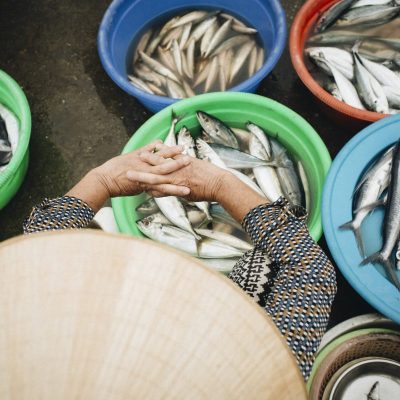A new study highlights the importance of collective action to boost resilience across all aquatic food systems to stave off the worst effects of climate change.
The Blue Food Assessment
The Blue Food Assessment (BFA) is an international joint initiative bringing together over 100 scientists from more than 25 institutions. Led by the Stockholm Resilience Centre at Stockholm University, Stanford University, and EAT, the Blue Food Assessment supports decision-makers in evaluating trade-offs and implementing solutions to build healthy, equitable and sustainable food systems.
Billions of people throughout the developing world could face heightened food and economic insecurity because of the threat climate change poses to aquatic food systems, new research reveals.
A new paper, entitled “Compound climate risks threaten aquatic food system benefits”, was one of five to be published as part of the Blue Food Assessment (BFA) in one of the most comprehensive reviews of the sector to date.
The authors warn that without mitigating the effects of climate change by reducing greenhouse gas emissions, societies that depend on aquatic foods will risk losing key contributions to livelihoods, economies, culture, health and nutrition.
 The research reveals, for the first time, the risk that climate change poses to the contribution made by aquatic foods towards human wellbeing and development around the world.
The research reveals, for the first time, the risk that climate change poses to the contribution made by aquatic foods towards human wellbeing and development around the world.
Without urgent action, capture fisheries – particularly in regions such as tropical Africa, Central America and the Indo-Pacific – face the most severe hazards. Aquaculture systems in off-shore and coastal waters, on the other hand, face lower climate-specific hazards, although freshwater aquaculture is exposed to high levels of hazard.
“This is the first paper of its kind to assess the risks climate change poses to all aquatic foods, including freshwater and marine, aquaculture and wild-caught, which provide employment to more than 100 million people and sustenance for more than three billion people worldwide,” said Michelle Tigchelaar, co-lead author and researcher at the Center for Ocean Solutions, Stanford University.
According to the study, countries that have traditionally been high emitters of greenhouse gas emissions do not necessarily face the highest risk from climate change, creating a need for a shared responsibility across countries and regions for climate-proofing aquatic food systems.
Countries in Southeast Asia, the Indo-Pacific and Africa, which are largely dependent on aquatic foods for sustaining livelihoods and economies, are facing the “double jeopardy” of climate change adversely impacting a critical economic sector.
In a high-emissions scenario by 2050, the paper found more than 50 countries face the triple threat of high climate hazards, exposure and vulnerability.
 “Mitigation of carbon emissions and adaptation to unavoidable impacts are both urgently needed. We need to focus on the broader social-ecological context of each country to ensure that climate solutions can build resilience and promote sustainable development,” said William W. L. Cheung, co-lead author and researcher at the Institute for the Oceans and Fisheries, The University of British Columbia.
“Mitigation of carbon emissions and adaptation to unavoidable impacts are both urgently needed. We need to focus on the broader social-ecological context of each country to ensure that climate solutions can build resilience and promote sustainable development,” said William W. L. Cheung, co-lead author and researcher at the Institute for the Oceans and Fisheries, The University of British Columbia.
“Early warning systems, disaster response plans, insurance schemes and safety nets will all be key in building resilience to these growing threats.”
In addition to recommending measures that enhance the climate resilience of aquatic food systems, the paper also highlights the need for transformative action to reduce climate vulnerability overall, including promoting gender equity, reducing poverty, and strengthening governance systems.
The full list of research papers produced as part of the Blue Food Assessment is available online. A list of the BFA leadership team is also available here.
Tags: Blue Food Assessment, climate change, CORU, faculty, food security, food webs, Research, William Cheung